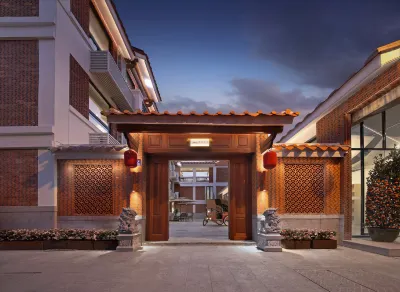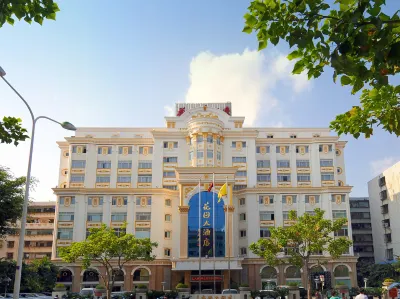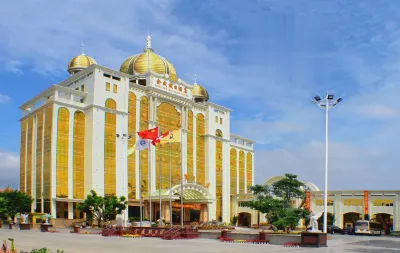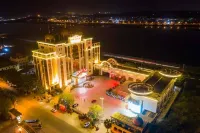
Odkryj pobyt w mieście Quanzhou
Wprowadź daty podróży, aby sprawdzić aktualne ceny i dostępność
Przesuń w górę, aby zobaczyć więcej
Filtruj według:
Liczba gwiazdek hotelu
≤2345
Popularne filtry
Niesamowity 4,5+Świetny 4,0+Dobry 3,5+Przyjemny 3,0+Znaleźliśmy dla Ciebie hotele (2553) w mieście Quanzhou
Wybierz daty podróży, aby zobaczyć aktualne ceny.
Najpopularniejsze
Najniższa cena
Blisko centrum
Najwyżej oceniane



Hotel w pobliżu: West Street/Kaiyuan Temple,Quanzhou 74.7% gości wybiera ten rejon
GGuest User 2024.04.08
We arrived on Friday, and the front desk lady told us that we were upgraded to an executive suite. We were quite happy. The room seemed to have been used as a wedding suite, and the wedding characters were not removed. The next day, when we came back from the tour, the housekeeper brought us bird's nest soup, which tasted good. Thank you very much!
The only drawback is that the service awareness of the waiters needs to be improved. The specific situation is: there was no mineral water in the room when we went out, and we asked the cleaning lady for it. She said that we had to go to the front desk downstairs to get it. When we went to the front desk, she said that the housekeeping department still had to provide it. Of course, the front desk still handled it and asked the waiter to bring it to us. However, the waiter clearly saw our group waiting in the lobby, and he didn't notify us when he got it. It was not until we got impatient and asked that we were given it. It was very unpleasant.
Excellent
Oceny: 351
4.4/5
Cena od
195 zł
za noc



Hotel w pobliżu: West Street/Kaiyuan Temple,Quanzhou 74.7% gości wybiera ten rejon
GGuest User 2024.10.05
The location of the B&B is very good. It is 100 meters away from West Street. The room is clean and tidy, with good sound insulation, so it is not noisy when sleeping. I have experienced the following items, and the staff are also very enthusiastic. I highly recommend it!
Outstanding
Oceny: 298
4.7/5
Cena od
278 zł
za noc



Hotel w pobliżu: Weat Lake Park/Qingyuan Mountain,Quanzhou
GGuest User 2024.07.13
The facilities of the homestay are all available and of high quality. Toiletries actually use Shiseido, cotton pads are also available, and there is an open kitchen. The environment is quiet and cozy. The room was warm and comfortable, and the bed was soft, so I slept soundly every night. The room is equipped with a balcony. It is perfect to have a cup of coffee or a small wine on the balcony at night, blow the natural wind, and read a book!
Very Good
Oceny: 40
4.2/5
Cena od
161 zł
za noc

Możesz preferować
Hotele ze śniadaniemHotele z pokojem z 2 łóżkami 1-osobowymiHotele z 1 podwójnym łóżkiemHotele z basenemHotele z bezpłatnym anulowaniem



Hotel w pobliżu: Jiangnan New Area,Quanzhou
GGuest User 2023.06.17
The room decoration is old-fashioned but the health is not bad. There is a small problem. The front desk has also actively dealt with it. The price is still very high. I will stay next time. There is a free buffet breakfast. It is also very good. I have to go outside to eat.
Oceny: 129
3.7/5
Cena od
167 zł
za noc



Hotel w pobliżu: Wanda Plaza/Fengze Square,Quanzhou 21.7% gości wybiera ten rejon
GGuest User 2023.10.06
Super favorite hotel! There are very few hotels with this tea ceremony theme, the creativity is great! The hotel facilities are very miserable and new, very clean and tidy. The service staff is very good and the breakfast is great. The dishes are delicious and the ingredients are fresh. highly recommended!
Excellent
Oceny: 113
4.5/5
Cena od
190 zł
za noc



Hotel w pobliżu: Weat Lake Park/Qingyuan Mountain,Quanzhou
TTravel Fifi 2023.12.27
The hotel is quietly located up on the mountain, we enjoy the hotel dedicated service, the team attends to details, and there is a WeChat group designated for our stay, so our meals and transportation needs are all met conveniently. We can brew a tea in the room and enjoy the greenery surrounding us. Car service is arranged to bring us downhill and since we came back quite late, we had asked for specific instructions for our own returning taxi. 很喜歡這裏細心到位的服務、幫我們搬運行李到達及離開房間、寧靜舒適的環境及睡房,安坐這裏,可慢活一整天,感受天地間美好的氣場。
Outstanding
Oceny: 460
4.7/5
Cena od
363 zł
za noc



Hotel w pobliżu: Weat Lake Park/Qingyuan Mountain,Quanzhou
GGuest User 2024.02.18
The room is very spacious, the ordinary big bed room is quite big, and the deluxe big bed room is even more luxurious. The noodle paste for breakfast is delicious, the ingredients are quite a lot, and the front desk also gave the child a breakfast coupon. Hotel transportation is also convenient, not far from where to go.
Very Good
Oceny: 338
4.2/5
Cena od
161 zł
za noc



Hotel w pobliżu: Wanda Plaza/Fengze Square,Quanzhou 21.7% gości wybiera ten rejon
YYese66 2024.03.10
The room was great, except for the window which was a bit unsatisfactory, everything else was perfect. The location of the hotel is great. There is a street full of food nearby. It is not a popular area like Bell Tower West Street. The food is more affordable, you know. It’s an old four-star hotel. The boss has put a lot of effort into the rooms. The bathrooms are clean, the bedding is good, and the stay experience is great. Transportation is very convenient, and the Quanzhou Overseas Transportation Museum is nearby. It is recommended to stay here.
Excellent
Oceny: 457
4.4/5
Cena od
146 zł
za noc



Hotel w pobliżu: Strait Sports Center/FUNWORLD,Quanzhou
GGuest User 2024.05.03
The hotel has complete facilities and is very crowded during holidays. The price has not increased yet, which really adds points to Luojiang Cultural Tourism. The staff has a good service attitude, rich breakfast, large room space, and gifts from southern Fujian are given to take back. Standard river view room.
Excellent
Oceny: 642
4.5/5
Cena od
157 zł
za noc



Hotel w pobliżu: West Street/Kaiyuan Temple,Quanzhou 74.7% gości wybiera ten rejon
GGuest User 2024.10.28
房間蠻乾淨的,在宋和鯉裏面。看似不方便因為不在西街中心,但是出門不影響,對我而言很方便,小白車可以預約接送,旁邊是當地人吃的阮記田螺路口是張記烤魚一到晚上人都很多,都是當地人,我因為一個人吃住無法品嚐美食,衹能下次再來,往前一點有一家炸物店叫西街…我忘記了,我買了炸紫菜好吃的,去晚了什麼都沒有了,我是當天沒買到,跟老闆娘説好第二天下午去買在高鐵上吃的。再往西街的方向走,有一段是生活區域走走看看吃吃當地的糕點很不錯。
Excellent
Oceny: 32
4.5/5
Cena od
111 zł
za noc
Najczęściej wybierane hotele w: Quanzhou, które są uwielbiane przez podróżników
Zobacz wszystkie
Wybierz jeden z najczęściej rezerwowanych hoteli w zeszłym miesiącu
No.1
4.5/5
1550 ocenaCitywell Hotel (Quanzhou Food Street)
Hotele w: Wanda Plaza/Fengze Square, Quanzhou 21.7% gości wybiera ten rejon
"Friendly front desk staff""Classy environment"
Wybierz daty, aby zobaczyć cenyNo.2
4.7/5
4822 ocenaEcharm Plus Hotel (Quanzhou Wanda Plaza)
Hotele w: Wanda Plaza/Fengze Square, Quanzhou 21.7% gości wybiera ten rejon
"Friendly front desk staff""Delicious breakfast"
Wybierz daty, aby zobaczyć cenyNo.3
4.7/5
5959 ocenaQuanzhou Hotel
Hotele w: West Street/Kaiyuan Temple, Quanzhou 74.7% gości wybiera ten rejon
"Convenient location""Friendly front desk staff"
Wybierz daty, aby zobaczyć cenyNo.4
4.7/5
2753 ocenaGrand Honor Hotel
Hotele w: Shishi
"Delicious breakfast""Classy environment"
Wybierz daty, aby zobaczyć cenyNo.5
4.8/5
165 ocenaQuanji Hotel (Quanzhou Zhongshan Road Branch)
Hotele w: West Street/Kaiyuan Temple, Quanzhou 74.7% gości wybiera ten rejon
"Convenient location""Great amenities"
Wybierz daty, aby zobaczyć cenyNo.6
4.6/5
703 ocenaMarco Polo (Jinjiang)
Hotele w: Quanzhou Jinjiang International Airport Area, Jinjiang 7.3% gości wybiera ten rejon
"Easy to get around""Delicious breakfast"
Wybierz daty, aby zobaczyć cenyNo.7
4.5/5
1050 ocenaQuanzhou Jinjiang Wudian Wanda Plaza Jinjiang Metropolo Hotel
Hotele w: Jinjiang Wanda Plaza/Wudianshi Traditional Blocks, Jinjiang 55.8% gości wybiera ten rejon
"Friendly front desk staff""Near shopping area"
Wybierz daty, aby zobaczyć cenyNo.8
4.7/5
4230 ocenaWanda Vista Quanzhou
Hotele w: Wanda Plaza/Fengze Square, Quanzhou 21.7% gości wybiera ten rejon
"Friendly front desk staff""Near shopping area"
Wybierz daty, aby zobaczyć cenyNo.9
4.7/5
3307 ocenaHoliday Inn Experss Quanzhou City Center
Hotele w: West Street/Kaiyuan Temple, Quanzhou 74.7% gości wybiera ten rejon
"Friendly front desk staff""Delicious breakfast"
Wybierz daty, aby zobaczyć cenyNo.10
4.7/5
2309 ocenaXIAMENAIR•QUANZHOU HOTEL
Hotele w: Wanda Plaza/Fengze Square, Quanzhou 21.7% gości wybiera ten rejon
"Delicious breakfast""Convenient location"
Wybierz daty, aby zobaczyć cenyObudź się na pyszne śniadanie w: Quanzhou
Zobacz wszystkie
Zacznij dzień od smacznego śniadania w jednym z naszych ulubionych hoteli w tym mieście
InterContinental Quanzhou
Hotele w: Xunpu Village/Donghai Taihe Plaza, Quanzhou 2.9% gości wybiera ten rejon
As an international hotel brand, InterContinental Quanzhou has become a highly anticipated core building in the city with its transcendent style and excellent quality. The hotel is located in the Donghai Taihe Plaza, which is known as a commercial aircraft carrier. It is built along the Jinjiang River and enjoys the beautiful city scenery. It is close to the Taikoo Plaza in the East Bay and the Xiapu Folk Culture Village. It is only a 20-minute drive from Jinjiang International Airport, a 30-minute drive from Quanzhou Railway Station, and a 5-minute drive to Jinjiang Bridge. InterContinental Quanzhou is happy to share more excitement with you, allowing you to enjoy the "InterContinental Life" while experiencing the comfort of "Knowing and Traveling in Quanzhou".
4.8/5
Outstanding4030 ocenaCena za noc od: PLN 457
Lvdao International Hotel
Hotele w: Shishi
Situated in the business district, the Lvdao International Hotel (Lvdao Guoji Jiudian) is a 20-minute drive from Jinjiang Airport. Quanzhou Railway Station is 40 km (25 mi) away. Rooms range from Deluxe Rooms to Continental Premier Suites and are equipped with standard amenities as well as mini bars, in-room safes and Wi-Fi Internet access. Dining choices on the premises include Chinese and Western restaurants, a coffee shop, a tea house and various bars.This complex offers well-appointed meeting rooms and a function hall for guests to conduct any of their work-related affairs.Guests with time for fun can enjoy a game of table tennis or break a sweat in the fitness center. There is also billiards, massage services and a sauna at guests' disposal.
4.7/5
Outstanding1251 ocenaCena za noc od: PLN 219
C&D Hotel Quanzhou
Hotele w: Wanda Plaza/Fengze Square, Quanzhou 21.7% gości wybiera ten rejon
The hotel, a member of Xiamen Jianfa Tourism Group, is located on the west side of Citong South Road, Fengze District, Quanzhou City, adjacent to the two major business districts of Lingshow World Creative Park and Puxi Wanda Plaza. You can "stay in a hotel and experience a city" here, follow the "Hand-drawn Tourism Map of Quanzhou" prepared in the guest room, find 22 intangible cultural heritage sites, and taste local snacks.The hotel has various high-end guest rooms, including superior floors, business floors, and executive floors. The design style is fashionable and elegant, the high-quality bedding creates a comfortable sleep, and the service team is warm and meticulous, providing you with a comfortable stay.The Yueyuan Cafe on the first floor of the hotel has a height of 9 meters and an elegant environment. It provides a variety of global buffets and Western-style a la carte dishes, and meticulous and thoughtful service to meet the needs of your taste buds.The business center is located in the executive lounge on the 28th floor, providing comprehensive business travel services. Guests staying on the executive floor can enjoy exclusive exquisite afternoon tea, leisurely happy hours and business negotiations here.The fitness center is equipped with a gym, indoor heated swimming pool and sauna and massage center.The gym uses facilities imported from Germany, including treadmills, spinning bikes, rowing machines and other training equipment to meet guests' various needs for aerobic exercise, strength training and body shaping; the indoor swimming pool uses a water circulation filtration system imported from Germany to ensure clean water quality. With a constant temperature of 26℃, you can enjoy swimming all year round.
4.8/5
Outstanding3269 ocenaCena za noc od: PLN 278
Pullman Quanzhou Shuitou
Hotele w: Nan'an
The hotel is located in Shuitou Town, Nan'an City, Fujian Province, China's "Stone Capital", in the bustling commercial district of the local area, and easy traffic to national scenic spot Anping Bridge. The hotel is built by the world-renowned design company CCD; Hotel has 240 comfort and modern style rooms, a diverse range of specialty dining and various leisure and relaxation venues, a fully equipped fitness center, an indoor swimming pool, will provide a enjoyable memory to guests.
4.7/5
Outstanding838 ocenaCena za noc od: PLN 237
Shishi Carnival Hotel
Hotele w: Shishi
Shishi Carnival Hotel was invested and built by Fujian Carnival Hotel Investment Management Co., Ltd. according to luxury standards. It has a building area of more than 60,000 square meters and has various luxurious guest rooms, complete supporting facilities and "intelligent guest control system". There are exquisite and characteristic cafeterias, luxuriously decorated KTV rooms, unique fitness centers, foot massage clubs and stylish outdoor swimming pools, etc. There are large department stores and shopping malls on the first to fourth floors, with all equipment and facilities. Complete. The hotel is located in the bustling commercial, entertainment, shopping and leisure area, in the bustling downtown area, with superior geographical location and extremely convenient transportation.
4.6/5
Outstanding1173 ocenaCena za noc od: PLN 161
Pullman Shishi Mattison
Hotele w: Shishi
Pullman Shishi Mattison is the first upscale International brand hotel integrating guest rooms, serviced apartments with entertainment, recreation and shopping malls in Shishi. Including hardbound apartments, executive floors and a presidential suite, the hotel features 350 luxurious guestrooms, which fuse modern art design concept. The very first helipad at the top of the hotel building in Quanzhou provides our distinguished guests a total novel and convenient stay experience. Café Aria, seated in the Lobby, supplies a variety of choices of food and beverage for 24 hours. The Mattison ballroom has 50 luxury dining theatre boxes with a strong flavor of Chinese characteristics. The elegance and taste makes it the best choice for delicate Fujian cuisine, Cantonese cuisine and other classic and delicious food. The total area of ballrooms and meeting rooms amounts to 2600㎡. The banquet hall in the 3rd floor is the pillar-less Grand ballroom with a total size of 1800㎡. It enables to cater to various high-end and personalized needs of large wedding and banquet ceremonies and other indoor activities. There are 8 multi-functional meeting rooms in the 4th floor. They integrate practical utility with luxury experience. Our well-equipped gymnasium, together with the outdoor swimming pool and SPA are the ideal places for your relaxation.
4.5/5
Excellent1364 ocenaCena za noc od: PLN 269
Shishi Wanjia International Hotel
Hotele w: Shishi
The Shishi Wanjia International Hotel (Shishi Wanjia Guoji Jiudian) is conveniently located in close proximity to Shishi Clothing City and the long-distance bus station.This luxury hotel combines classic Oriental and European styles, with a variety of rooms available at the guest's disposal. Other amenities include a gym, spa, sauna, swimming pool, shopping center, business center, function room, banquet hall and on-site restaurant. There are also 70 private karaoke rooms available for you to sing in.
4.6/5
Outstanding1148 ocenaCena za noc od: PLN 165
Grand Honor International Hotel
Hotele w: Jinjiang Wanda Plaza/Wudianshi Traditional Blocks, Jinjiang 55.8% gości wybiera ten rejon
The Grand Honor Hotel (Rongyu Guoji Jiudian) is located in central Jinjiang, 14 km (9 mi) from Jinjiang Railway Station. The hotel is just 5 minutes' drive from Jinjiang Airport, from which airport pickup is available.The on-site restaurants serve local Chinese cuisine and Western cuisine for those in need of some home comforts.For those traveling on business the hotel features various conference rooms with audio visual equipment as well a business center.Guests at this Jinjiang hotel can indulge with the massage and sauna facilities or relax with a dip in the indoor pool. For those wanting to keep active there are gym and tennis facilities available.
4.7/5
Outstanding1166 ocenaCena za noc od: PLN 195
Crowne Plaza Quanzhou Riverview, an IHG Hotel
Hotele w: Jiangnan New Area, Quanzhou
Crowne Plaza Quanzhou Riverview is located in Licheng Jiangnan New District, adjacent to the beautiful Jinjiang River, out of the bustling ancient city new area, into the "riverside" tranquility. Surrounded by commercial complexes, the hotel is easily accessible for business offices and leisure shopping. The hotel is ideally located 4.5 km from Quanzhou Railway Station and 15.5 km from Jinjiang International Airport. The hotel has a total of 368 rooms and serviced apartments, 4 restaurants and a lobby lounge. With a comfortable living and parking atmosphere, a full range of catering, conference and entertainment facilities, it is the ideal choice for your stylish travel and business travel.
4.8/5
Outstanding3294 ocenaCena za noc od: PLN 404
Jinjiang Xiamenair hotel
Hotele w: Quanzhou Jinjiang International Airport Area, Jinjiang 7.3% gości wybiera ten rejon
The Xiamen Air Hotels Jinjiang was recently opened in 2022, making it a fantastic choice for those staying in Jinjiang. The hotel is conveniently located just 500m from Jinjiang Airport and 11km from Quanzhounan Railway Station. There is no shortage of things to see in the area, with the Sunshine Times Square, Shiji Park Amusement Park and Tangmumao Amusement Park all nearby. In their spare time, guests can explore the hotel's surroundings. This Jinjiang hotel offers parking on site. There's never a dull moment at this hotel, our guests indicate that the facilities are excellent. Perfect for those working on the move, this hotel caters to a large number of business guests.
4.8/5
Outstanding1880 ocenaCena za noc od: PLN 192
Odkryj naszą starannie wybraną kolekcję 4-gwiazdkowych hoteli w: Quanzhou
Zobacz wszystkie
Niezależnie od tego, czy podróżujesz w interesach, czy prywatnie, te czterogwiazdkowe hotele sprawdzą się idealnie
Kyriad Hotel (Quanzhou Jinjiang International Airport)
Hotele w: Jinjiang Wanda Plaza/Wudianshi Traditional Blocks, Jinjiang 55.8% gości wybiera ten rejon
The Kyriad Hotel (Quanzhou Jinjiang International Airport) is a great choice for guests looking for accommodation in Jinjiang, having been recently opened in 2022. The hotel is only 5km from Quanzhou Jinjiang International Airport and 15km from Jinjiang Railway Station, giving guests a number of convenient transportation options. With multiple attractions nearby including Shigu Temple, Quanzhou String Puppet Show Performance and Qingyang Mountain, guests will find plenty to keep themselves occupied. At the end of a busy day, travelers can unwind and relax in the hotel or go out and enjoy the city. For those driving themselves, parking is provided on site. If cleanliness is important to you, this hotel makes an excellent choice, as our guests consider this to be one of the cleanest hotels in the city. Perfect for those working on the move, this hotel caters to a large number of business guests.
4.8/5
Outstanding1742 ocenaCena za noc od: PLN 154
Jinjiang Metropolo Quanzhou Jinjiang Airport Sunshine Plaza Airport Hotel
Hotele w: Quanzhou Jinjiang International Airport Area, Jinjiang 7.3% gości wybiera ten rejon
The hotel is located on Yangguang Road, the core business district of Jinjiang, Quanzhou, one of the top 100 counties in China and the world shoe capital. The Sunshine Night Market is downstairs,It is adjacent to the traditional cultural tourism area of Minnan - the old block of Wudian City, and is adjacent to the famous night market in Fujian - Yangguang Night Market and Jinjiang Wanda Plaza. It is only a 15 minute drive from Quanzhou West Street. The surrounding facilities of the hotel are complete and the transportation is convenient. There are well-known restaurants such as Starbucks, McDonald's, KFC, and Haidilao, which are only a 5-minute drive from Jinjiang International Airport and a 25 minute drive from Jinjiang High speed Railway Station.The hotel has 109 rooms of various types, including Metropolitan King, Metropolitan Twin, Elegant King, Elegant Suite, and Family Suite. The rooms are spacious, with a wide view, intelligent guest control, and elegant decoration style.On the left side of the first floor of the hotel, there is a 350 square meter self-service breakfast restaurant that can accommodate 88 guests at the same time. It has a wide variety of dishes, with over 68 dishes and traditional snacks from southern Fujian, delicious and delicious; On the right side, there is a lobby bar and a tea tasting room, providing you with a luxurious afternoon tea experience. The second floor is equipped with a multifunctional conference hall, and the desk room can accommodate 80 guests at the same time. In addition, there is a self-service laundry room and a self-service gym, providing a meticulous accommodation experience for guests who are staying.
4.7/5
Outstanding540 ocenaCena za noc od: PLN 132
Baozhou Road, Quanzhou, Hongchang, Yadu Hotel
Hotele w: Wanda Plaza/Fengze Square, Quanzhou 21.7% gości wybiera ten rejon
The Baozhou Road, Quanzhou, Hongchang, Yadu Hotel is a great choice for guests looking for accommodation in Quanzhou, having been recently opened in 2022. With Quanzhou Jinjiang International Airport just 11km away and Quanzhou Railway Station only 13km away, transportation is very convenient. With multiple attractions nearby including Quanzhou Tianhou Temple, Quanzhou Ancient City and QuanZhou QiaoXiang ShangPin Jie, guests will find plenty to keep themselves occupied. After a long day of sightseeing, guests can retire to the comfort of the hotel. For those driving themselves, parking is provided on site. There's never a dull moment at this hotel, our guests indicate that the facilities are excellent. This hotel is a popular accommodation for groups of friends traveling together.
4.8/5
Outstanding3209 ocenaCena za noc od: PLN 219
Hotel Brilliant
Hotele w: Shishi
The Hotel Brilliant (Bolai Jiudian) is in the center of Shishi city. It's a modern deluxe business hotel, providing such amenities as Internet access, coffee bar and non-smoking rooms. In addition, there is a large-scale function hall, offering plenty of business facilities or entertainment options for social events. International travelers will appreciate the available use of international credit cards, currency exchange and ticket booking services.
4.7/5
Outstanding1691 ocenaCena za noc od: PLN 118
Wanjia International Hotel
Hotele w: Jinjiang
The Wanjia International Hotel is an ideal spot for travelers wanting to discover the city. Visitors to Jinjiang will find that the Wanjia International Hotel is a fantastic accommodation choice. The hotel is 28km from Quanzhounan Railway Station and 33km from Quanzhou Jinjiang International Airport. This hotel is located near many of Jinjiang's attractions including Weitou Village, Shizhen Beach and Antenna Beach. At the end of a busy day, travelers can unwind and relax in the hotel or go out and enjoy the city. For those driving themselves, parking is provided on site. When it comes to Jinjiang hotels, the Wanjia International Hotel is highly regarded for its excellent facilities. Perfect for those working on the move, this hotel caters to a large number of business guests.
4.5/5
Excellent1303 ocenaCena za noc od: PLN 111
Quanzhou Shishi Dehui Plaza Atour Hotel
Hotele w: Shishi
The hotel is situated on Jinsheng Road, within the core business district of Shishi City, Quanzhou—an international clothing hub. It is conveniently located near the picturesque Western Park and Turtle Lake Park, with easy access to Taihe Square and Dehui Square. Surrounding shops enhance the superior environment, offering ample shopping and entertainment facilities. The hotel is in close proximity to renowned dining establishments such as Jianming Haven Seafood Hotel and Jianming International Entertainment, as well as being a short walk from Shishi City Hospital of Traditional Chinese Medicine. Additionally, it is approximately 1.5 km from the long-distance passenger station, 2.5 km from the Fu-Xiamen Expressway, 10 km from Jinjiang International Airport, 18 km from Jinjiang High-Speed Railway Station, and 30 km from Quanzhou High-Speed Railway Station. The hotel's surroundings are tranquil and elegant; its design integrates local culture into every detail while being adjacent to popular tourist attractions like Hongta Bay and Luojia Temple—making it an ideal choice for both business trips and leisure stays in Quanzhou's Stone Lion area.The hotel embodies the brand’s commitment to humanistic spirit and service excellence through a design concept centered around reading and humanities that harmonizes urban aesthetics with lifestyle needs—creating a new space for social travel experiences. Its facilities are comprehensive: featuring a Chinese-Western buffet breakfast restaurant, gymnasium, laundry room, library—all designed to provide you with a warm home-like experience.Accommodations include comfortable quiet rooms equipped with advanced intelligent amenities (such as semi-intelligent toilets and smart robots). All rooms feature high-quality Plante bedding products along with natural Sahe toiletries; central air conditioning; TV projection screens; high-speed fiber-optic internet services.Breakfast offerings are diverse—including local specialties aimed at enriching guests' culinary experiences during their stay; this daily ritual fosters warmth among patrons.Fitness enthusiasts can enjoy round-the-clock access to our gym—a testament to an active lifestyle—with state-of-the-art oxygenated exercise equipment alongside strength training facilities that make workouts enjoyable while rejuvenating tired bodies.Laundry services ensure your clothes remain clean and dry throughout your stay—the hotel provides convenient dust-out times for refreshing garments before setting out again.The Bamboo House serves as Yatou Hotel's 24/7 library named after "Bamboo Jane," supporting free borrowing options across more than 160 cities nationwide—with over one million books available for lending—allowing literature to accompany you wherever you go.
4.8/5
Outstanding353 ocenaCena za noc od: PLN 167
HOME2 SUITES BY HILTON QUANZHOU ANXI
Hotele w: Anxi
The hotel is located in the wealth center square business district of Anxi city, Anxi county has a long history, taking the meaning of the stream flow. Known for its tea industry in China and abroad, known as the Chinese tea capital, the birthplace of the world's famous tea - Tieguanyin. The Chinese and world's cane iron technology. Tourism to clear water rock, Confucian Temple, City God Temple is the most famous. The hotel is conveniently located near the surrounding supporting life, can easily reach the commercial points and tourist attractions, about 20 minutes from Anxi East Station, Quanzhou Station 50 minutes, Jinjiang Airport about 75 minutes, Xiamen North Station or Gaoqi Airport about 60 minutes' drive. The hotel's shared social hall, smart guest rooms to create a new "sojourn" concept, restaurants, gyms, self-service laundry, and meeting rooms can accommodate 200 people and so on. Whether you are busy business people or family or individual travel, let you in this charming city more warm and comfortable. Treat each other sincerely, intimate not disturb, let us open with you a comfortable sojourn experience!
4.7/5
Outstanding369 ocenaCena za noc od: PLN 158
Quanzhou Jinjiang Airport Sunshine Road Atour Hotel
Hotele w: Quanzhou Jinjiang International Airport Area, Jinjiang 7.3% gości wybiera ten rejon
The hotel is located on Yangguang Road, the core business district of Jinjiang City, Quanzhou, known as the World Heritage City and the world shoe capital. It is adjacent to the cultural district of Wudian City, a landmark in southern Fujian, and is close to the bustling and smoky Yangguang Road and Wanda Plaza. Quanzhou West Street is conveniently accessible. The surrounding shops stand tall and the environment is superior, with shopping centers, entertainment facilities, and convenient amenities available, such as famous restaurants like Starbucks and Haidilao, as well as Jinjiang Traditional Chinese Medicine Hospital. Convenient transportation, only a 5-minute drive from Jinjiang Airport, covering Quanzhou and the core business district of Jinjiang within 30 minutes. There are also various Minnan characteristic buildings and venues that offer a panoramic view of world cultural heritage. The hotel is surrounded by an elegant environment, incorporating urban culture into every detail of the hotel. The design concept of the hotel is centered around reading and humanistic photography, creating a comfortable, simple, down-to-earth, and peaceful accommodation experience for you. The hotel's super large reading club "Zhuju" provides 24-hour reading space, bringing you a spiritual habitat. The hotel provides photography works in each room, aiming to recreate the past and present of a city and taste its unique character. All rooms in the hotel are equipped with high-quality bedding from the Plant series; A complete set of high-end bath products, providing physical and mental pleasure, and enjoying travel; The hotel has a restaurant (signature), a gym (sweating out), and a 24-hour laundry room for washing, ironing, and drying (dust removal). The design incorporates a natural, simple, peaceful, and warm style, all meticulously elegant and unique. It is your choice to stay in Jinjiang, Quanzhou for business trips and tourism. All partners warmly welcome your arrival.
4.8/5
Outstanding932 ocenaCena za noc od: PLN 176
Quanzhou West Street Gucheng Alley Yu Hotel
Hotele w: West Street/Kaiyuan Temple, Quanzhou 74.7% gości wybiera ten rejon
This is the second time I stayed at Xiangyu Hotel! I locked this hotel when I came to Quanzhou for a trip~ The price-performance ratio is very high in all aspects, and Quanzhou Cultural Tourism Direct Hotel is very reliable! Thank you for the warm hospitality of housekeeper Zhuangzhuang, Xiao Li, and Xiao Zhang! Let me elaborate on the advantages of the hotel for reference by friends who come to travel:
1. The geographical location is excellent. It is located in Tongzheng Lane, Zhongshan Road. It takes 5 minutes to walk to the hotel from the airport/high-speed rail station to the bell tower. You can take a small white car for daily travel. You can take a small white car to various scenic spots by walking 1 minute to the entrance of Tongzheng Lane.
2. The hardware facilities are comprehensive. This hotel has an elevator, which is very important! Many homestays and hotels in the ancient city of Quanzhou do not have elevators. It is really inconvenient to carry luggage upstairs. There are tea bags and drinks in the room, welcome fruits will be given when you check in, and the toilet is fully automatic. The breakfast is rich, and there will be free sugar water every night! The bed is very comfortable, the pillows are also very comfortable. We booked a room with a bathtub. Every day, a plastic cover for the bathtub will be provided for bathing, and the room will be cleaned every day.
3. The service is really great! We will contact you one day in advance to confirm the check-in time. Check-in is very fast. We will share the travel guide of Quanzhou in advance for reference. This time I came to play and it happened to be my birthday. The hotel also sent a cake and a handwritten greeting card. I was really touched! Full of heart!
4. There are many activities in the hotel. There is a small intangible cultural heritage museum in the hotel. You can watch puppet shows, so you don’t need to go to the puppet theater. There are also small cultural and creative products to buy~
4.8/5
Outstanding990 ocenaCena za noc od: PLN 360
Quanzhou Great Wall Days Hotel
Hotele w: West Street/Kaiyuan Temple, Quanzhou 74.7% gości wybiera ten rejon
The Days Inn Hotel Great Wall Quanzhou (Quanzhou Changcheng Days Inn Jiudian) is a business hotel located on North Wenling Road in Licheng District.On-site dining venues include a lobby bar, cafe and Western restaurant.Business guests may make good use of the meeting room.For self-driving guests, a parking lot is provided free of charge.
4.4/5
Excellent2907 ocenaCena za noc od: PLN 127
Zobacz, jak inni podróżnicy ocenili hotele w: Quanzhou
Zobacz wszystkie
Przeglądaj autentyczne oceny i opinie prawdziwych podróżników, które pomogą Ci znaleźć idealne zakwaterowanie
4.9/5
Perfect
A very good hotel! The actual room is more beautiful than the picture on the home page, and it is very comfortable to live in. I stayed with my two female friends during this time, and there was no problem with the cleanliness. Moreover, this hotel has a very obvious Minnan flavor. At first glance, it belongs to the owner of Minnan. Hotel, there are tea sets and tea leaves in the room, the seats are mahogany furniture, and the materials of other facilities in the room are very good. The boss is very willing to spend money and pays attention to the decoration. Some room types in the hotel also have conference rooms. The boss is very creative in the decoration. , I took the clothes off to wash in the evening and picked them up at noon the next day. The hotel staff had already hung them up for me because the sun was stronger in the morning. All the hotel staff were very nice and very friendly. It was basically the best way to go to the scenic spots from here. It's about two kilometers away and the transportation is very convenient.
Fengze Ji'an Apartment
Hotele w: Wanda Plaza/Fengze Square, Quanzhou 21.7% gości wybiera ten rejon
Cena za noc od: PLN 58
4.8/5
Outstanding
GGuest UserThe environment of the homestay is very comfortable. The reception auntie was very good (we didn't bring a power bank, so the auntie directly brought one to our room and replaced it at any time if it ran out of power). The breakfast was also very rich and you could take it to the yard to eat. It was very comfortable. The auntie was also very enthusiastic and would accompany us to buy local specialties. The experience was really great
Quanzhou Zhixing Wujie Homestay
Hotele w: West Street/Kaiyuan Temple, Quanzhou 74.7% gości wybiera ten rejon
Cena za noc od: PLN 46
4.8/5
Outstanding
AAnonymous UserThe location is quite good, there are not too many people, and the navigation instructions given by the store are also very clear. There are many places to eat downstairs, and it is also very convenient to go to West Street. The rooftop terrace has a good view, and the overall decoration is retro and simple, which is quite comfortable.
The overall facilities are okay. The design of the shower is not very reasonable. There is a protruding part of the wall next to it that is easy to hit. The wet and dry separation is average.
The room is very spacious, but the smell of rags is a bit obvious after cleaning just after entering the door. The service staff are very nice.
TuJi·XiangYu
Hotele w: West Street/Kaiyuan Temple, Quanzhou 74.7% gości wybiera ten rejon
Cena za noc od: PLN 216
4.8/5
Outstanding
GGuest UserThe front desk staff are very welcoming. When I checked in, I met the female manager of the hotel (sorry, I asked her last name but forgot her name) who introduced the hotel's facilities and services very enthusiastically. The room is small but very clean. There is no view outside the window but it is very quiet. There is a coffee machine in the lobby, the coffee is good, and many small items are thoughtfully prepared, such as paper towels, mosquito repellent, band-aids, etc. The hotel is nearly two kilometers away from Xintian City Plaza. It’s about 4 kilometers to West Street by taxi.
The disadvantages are: the surrounding environment of the hotel is not very good, the breakfast is very simple and not delicious, and the chef in the restaurant is too talkative. We arrived at the restaurant at 8:30, and before we finished eating, he cleaned up in various ways, just like chasing away guests. So, there is no need to pay extra for breakfast.
Ruishe Hotel (Xintian City Plaza, Licheng)
Hotele w: Jiangnan New Area, Quanzhou
Cena za noc od: PLN 161
4.8/5
Outstanding
OOOI YEW TEIKI recently had the pleasure of staying at this wonderful 4-star hotel in Jinjiang, and it was truly an exceptional experience. The hotel offers a fresh, modern, and comfortable environment that exceeds expectations. From the moment I arrived, I was impressed by the cleanliness, thoughtful design, and welcoming atmosphere.
Compared to the Xiamen branch, my experience here was significantly better. The attention to detail, quality of service, and overall ambiance were remarkable. The rooms are spacious, well-equipped, and impeccably maintained, ensuring a restful and enjoyable stay. The fresh views from the hotel added a delightful touch to my trip, making it a refreshing experience.
The staff deserves special mention for their professionalism and friendliness, always ready to assist with a warm smile. The facilities are top-notch, catering to both business and leisure travelers alike, with everything you need for a comfortable and memorable stay.
I genuinely enjoyed my time here and am looking forward to returning in the future. Without a doubt, this is the best 4-star hotel in the Jinjiang area, and I highly recommend it to anyone visiting the region.
Hampton by Hilton Quanzhou Jinjiang International Airport
Hotele w: Jinjiang Wanda Plaza/Wudianshi Traditional Blocks, Jinjiang 55.8% gości wybiera ten rejon
Cena za noc od: PLN 228
4.7/5
Outstanding
AAN NEEThe accommodation is a room in a triple storey terrace house in a quiet area. It is in quite a central location but you need to walk about 7 mins from the main street to get to the house. The area is safe to walk in even when at night. There many food shops along the main street. You can also catch the white mini bus there. Our room was on the 2nd floor (Chinese 3rd floor). It was quite cold when we were there. There is no hot air conditioning. We were given a small heater. It kept the room warm but it couldn't dry the tiled flooring so the floor got messy from us walking in & out from the bathroom. Otherwise, the place is very clean. Toiletries & slippers provided. There is a washing machine on the top floor, free to use but no dryer. Our clothes had difficulty drying as the drying area is a room with closed windows. Shower area & toilet is together. There is a small room where you can hand wash your clothes if you want to buy I wouldn't advise that as drying is difficult. No lift. There is no fire escape since it is a private house. You need to contact the owner to inform him ahead of your date & time of arrival as he is not there all the time. He is friendly & helpful.
Quanzhou well home stay
Hotele w: West Street/Kaiyuan Temple, Quanzhou 74.7% gości wybiera ten rejon
Cena za noc od: PLN 122
4.6/5
Outstanding
GGuest UserThe hotel is right by the West Lake, with a beautiful environment. The room is clean and tidy, the service staff is warm and polite, and the Dabai Bus Terminal is right at the door, which is very convenient for visiting the ancient city. The hotel also offers self-service check-in!
Quanzhou West Lake Hotel Apartment
Hotele w: Weat Lake Park/Qingyuan Mountain, Quanzhou
Cena za noc od: PLN 249
4.6/5
Outstanding
红红月I spent 6 nights at 2208. It had been saved on my Trip.com for many months before my summer holiday, so I was happy that they had availability for the week I planned to visit.
In order of importance for me as a solo (foreign female) traveler are: location, safety, and helpfulness of staff.
1. Location: I think the location is perfect. It’s on a small alley behind West Street and directly across from Kaiyuan Temple’s west gate. This area is very central and convenient.
2. Safety: Overall, the city is safe, but in reality it is nearby a main tourist destination, so to prevent non-guests from entering there is a gate with keypad access for late night. There was always staff inside at other times.
3. Helpfulness of staff: There were some language barriers due to my lack of fluency, but the staff tried to help as much as possible to make sure I was comfortable. If there was a problem it was resolved quickly and if I didn’t understand, they were patient and tried to explain it another way.
Other than these things, I’ll say there are actually two 2208 buildings in the same area. One has a view of Kaiyuan Temple from some rooms and from the rooftop; the other seems more modern but without this view. There is cleaning service available if you need it and free water bottles daily.
If you are looking for amenities such as a television or breakfast, maybe this is not a suitable option, but if you want a place to sleep nearby the best sites in Quanzhou, and have friendly staff greet you each day, then it’s a good choice.
2208 Inn (Quanzhou West Street Kaiyuan Temple Branch)
Hotele w: West Street/Kaiyuan Temple, Quanzhou 74.7% gości wybiera ten rejon
Cena za noc od: PLN 106
4.6/5
Outstanding
LLeeA warm welcome by hotel staff,Connie (小余)with fruits and was personally guided to our rm on the 2nd floor. A spacious 40m/sq rm with fascinating seaview meets our eyes. Rm was clean and not a smoking one as preference requested. A highly recommended vacation accommodation. Ideal location with walking distances to various eateries and attractions. Will be back to enjoy the facilities such as swimming pools and KTV. Staff were polite and breakfast was good with some rm of improvement. Thanks Connie and all west gulf staff.
4.4/5
Excellent
EEmily YingThis homestay is superb for me and my family member from Malaysia. The location is great and the pin location is accurate is u grab car from Didi.
This homestay can grab Didi anytime.The shop Opposite hotel is 老字号马蹄酥&黄衍明口腔科 as later i will put picture for ur reference. Then u follow the signboard go in the alley then can find the homestay. The owner of this homestay is super helpful and friendly. As my luggage damage in airport, owner help me to get a new luggage online and get it just within a day. The homestay even provide us disposable towel ,face towel , tooth brush and tooth paste everyday. And no need worry about shampoo and body shampoo too. Hassle free and can bring less item if u stay in this homestay. The hotel location is great to grab breakfast and supper too. Some within walking distance restaurant I will put in photo. And 小白车u can take from this homestay to many travel attraction just rmb 2. All in all, this homestay is good value for money and i would like say thank you to the owner of this homestay for the pleasant stay during my trip. Definitely we will come back again Quanzhou just want stay in Lanxin courtyard only.
这家民宿对我和我来自马来西亚的家人来说太棒了。位置很好,如果你用滴滴打车,定位很准确。这里打车很方便。酒店对面的商店是老字号马蹄酥&黄衍明口腔科,稍后我会贴上图片供你参考。然后你跟着招牌走进小巷就能找到民宿。这家民宿 的主人非常乐于助人和友好。由于我的行李在机场损坏了,主人帮助我在网上买了一个新行李,一天之内就拿到了。民宿甚至每天为我们提供一次性毛巾、面巾、牙刷和牙膏。也不用担心洗发水和沐浴露。如果你住在这家民宿可以带更少的物品省略不少行李过重的麻烦。酒店位置很棒,三餐都能吃到好吃的食物。一些步行距离内的餐厅我会贴在照片里。而且从这家民宿乘坐小白车前往许多旅游景点只需 2 元人民币。总而言之,这家民宿物超所值,我要感谢民宿主人让我在旅途中住得愉快。我们一定会再来泉州,再次住在蓝馨。或许可以说是蓝馨让我爱上了泉州,这个充满人情味的民宿。
Quanzhou Lanxin Courtyard
Hotele w: West Street/Kaiyuan Temple, Quanzhou 74.7% gości wybiera ten rejon
Cena za noc od: PLN 95
Jak podróżni oceniają atrakcje w: Quanzhou
Odkryj te miejsca, które warto odwiedzić w mieście Quanzhou i wybierz pobliski hotel dla większej wygody
West Street
柠柠de旅行者Quanzhou West Street is like a living historical scroll, carrying the unparalleled elegance of a thousand years, flowing quietly in the long river of time, exuding charming charm.
When you step into West Street, the first thing that catches your eye is the old and charming buildings. The architectural style of West Street combines the Central Plains culture with the characteristics of southern Fujian. Red brick old houses, arcades and Western-style buildings are intertwined, and flying eaves, brackets, carved beams and painted buildings tell the glory of the past. Every stone slab has been polished smooth by the years, as if whispering the prosperity of the past, witnessing the glory and hustle and bustle of Quanzhou as the starting point of the Maritime Silk Road. The Kaiyuan Temple on West Street is the pearl of West Street. The east and west towers stand tall and point to the sky. Its exquisite architectural craftsmanship is breathtaking. The temple is filled with incense, ancient trees are towering, and the quiet and peaceful atmosphere makes people forget the troubles of the world and immerse themselves in the sacredness and solemnity of this thousand-year-old temple.
West Street is not just a historical exhibition hall, it is also a stage of life full of vitality and fireworks. Traditional snack stalls exude tempting aromas, and there are a wide variety of delicacies such as noodle soup, runbing dishes, and man-fried cakes. Every bite is the ultimate experience of southern Fujian flavor, satisfying the discerning taste buds of diners. There are a wide variety of specialty shops selling traditional handicrafts, antiques, calligraphy and paintings, local specialties, etc., which are dazzling. Here, tradition and modernity blend with each other, and the ancient streets are rejuvenated with new vitality. The performances of street artists are wonderful, and the melodious music and smart dances attract many tourists to stop and appreciate, adding a different color to West Street.
West Street is also an important link for cultural inheritance. The lingering Nanyin, the rhyme of Liyuan Opera, and the vivid puppet show are all inherited and carried forward in West Street, allowing people to feel the profoundness and unique charm of southern Fujian culture. West Street carries the nostalgia and memory of Quanzhou people and is the eternal spiritual home in the hearts of Quanzhou people. It is not only a street, but also a symbol of Quanzhou's history and culture and the soul of the city. With its unique charm, it attracts tourists from all over the world, allowing people to appreciate the charm and style of the thousand-year-old city, shining brightly in the passage of time. Whether it is to explore historical relics, taste food culture, or feel the fireworks of the world, West Street is undoubtedly the best choice. It is like a bright pearl, inlaid in this ancient and magical land of Quanzhou, emitting an indelible light.
Quanzhou Kaiyuan Temple
山山在穷游How can you not come to Quanzhou to Kaiyuan Temple? Kaiyuan Temple is a must-see attraction in Quanzhou Ancient City. Of course, Kaiyuan Temple is really not just looking at two towers. In addition to looking at the East and West Towers, the building of the temple itself is also very majestic.
Quanzhou Ancient City
山山在穷游I think everyone should be familiar with the ancient city of Quanzhou in recent years. A West Street can make the whole Quanzhou popular. But now the ancient city of Quanzhou is really different from the past. In addition to the crowds of people, there are businesses everywhere. If you want to experience a quiet ancient city of Quanzhou, it is really too difficult.
All Love Park Ocean Kingdom
私私语萧萧The off-season park is estimated to be less than 300 tourists, but there are no fewer performances, but the experience is very good, there are few people and some rides are not open, the dolphin beluga performance is quite satisfactory, the undersea tunnel, the mermaid performance and the big circus with children are really good, the downside is the catering, overall satisfaction!
Gold Coast
难难 得糊 涂Shishi Shili Golden Coast is a famous coastal tourist resort in Shishi City, famous for its beautiful coastline and rich tourist resources. The following is some brief information about Shishi Shili Golden Coast:
• Geographical location and features: Shishi Shili Golden Coast is located in Yongning Town, Shishi, Quanzhou City, Fujian Province, with a 68-kilometer winding and charming coastline. It is surrounded by the sea on three sides and is famous for its blue sky, highway, sea, well-arranged traffic lights and zebra crossings, and the endless sea surface.
• Tourism resources: There are many "Internet celebrity" check-in points along the Shili Golden Coast, including Hongta Bay Tourist Highway, Jinjiang Outer Line, Wetland Park, Gu Fuwan Slow Life Experience Area, Xiangzhi Fishing Port, Wubao Outpost, Military Park, etc. These attractions are strung together to become the representative work of Shishi's "coastal tourist destination".
• Opening hours and tickets: Shishi Golden Coast is open all day and tickets are free.
• Planned area and investment: The Golden Coast is planned to cover an area of 6,000 acres with an investment of nearly 300 million yuan.
• Suitable season for visiting: Summer is the suitable season for visiting Shishi Golden Coast.
• Suggested duration of visit: The recommended duration of visit is 1-2 hours.
• Transportation: Visitors can choose to drive by themselves, or take a taxi or bus (Shishi Road 5, Shishi Tourism Yongjun Road).
• Surrounding attractions: In addition to the beach, the Ten-mile Golden Coast also includes Military Park, Luojia Temple, Yongning Ancient City, Guanyin Mountain and other attractions worth checking in.
• Tourism development: Shishi City has promoted the coordinated development of mountains, seas and cities through measures such as coastal zone planning, development and construction, and the creation of coastal landscape roads, so as to better connect the natural scenery and cultural attractions along the route.
Shishi Ten-mile Golden Coast has become a popular choice for tourists' coastal tourism with its unique seaside scenery and rich tourism resources.
Xun Pu
山山在穷游Just a travel photography, a village that was not particularly famous was brought to fire. When you go to this village, you will find all the beautiful women wearing flowers. There is really no scenery. Only people are better than to walk to his riverside. I heard from the locals that this riverside was also mounded.
Luojia Temple
山山在穷游Because a star made a place popular, and it was a temple, I think Luojia Temple is one of the representatives. This temple is known as the temple on the sea. It was built here perhaps to get away from the city and live in peace, but now tourists have made it full of people taking pictures. It is recommended that you choose good weather to come here, otherwise you will be very disappointed.
Jinjiang Wudianshi Traditional Blocks
山山在穷游When I came to Jinjiang, I still recommend everyone to take a look at Wudian City. He is entering such a city center. This is really a business and. The center of culture, there are emerging businesses, and there is also an ancient culture. I came here at night. I heard that I can go shopping more clearly during the day and make more movies at night.
The Ancient Town of Chongwu
晨晨光2023First of all, the ancient city wall of Chongwu is a must-see, as a representative of the sea defense project in the Ming Dynasty, it is very well preserved, made of granite, very strong, and the view of the city wall is super good, you can see half the ancient city and half the sea spectacular scene. Secondly, Chongwu ancient city is distributed inside and outside many exquisite stone carvings, including stone lions, stone statues, etc., the ancient city also has the reputation of "the land of stone carvings"! Of course, you can also experience the seaside scenery of Chongwu. The ancient city is close to the sea, with beautiful beaches and clear seawater. It is a good place to watch the sunrise and sunset and experience the seaside life. In addition, there are many historical relics in the ancient city, such as the ancient city gate, ancient fort, sea tides, Guandi Temple, etc., you can feel the weight of history while visiting.
Qingyuan Mountain
MM43***19It is very worth watching. I personally feel that it is the preferred destination for Quanzhou tourism to climb Nantai Rock, and have a panoramic view of Quanzhou City. It is as green as a belt in Jinjiang. It is close to the landscape of the West Lake. It is refreshing and pleasant. It has been a long-term tour. Qingyuan Mountain is worthy of being a national five-A scenic spot. The scenic spots are fully equipped. Systemic logos and introductions, add historical knowledge and legends and myths and other human geography anecdotes during the tour. The scenic mountain climbing stone steps are laid with care, and the mountain leads the leisurely steps. Even the elderly do not feel hard work. There are several rest seats along the way. It is a deep joy for tourists to be secretly happy.~ Laojunyan, Mituoyan, Yishi Sheli Tower, Nantai Temple and other attractions are impressive.~ The whole mountain is full of ancient trees. Towering, such as a green umbrella, the sky is cool, comfortable, forgetting the world
Quanzhou – Często zadawane pytania
Które hotele w: Quanzhou są popularne?
Quanzhou oferuje wiele popularnych hoteli. Zarówno podróżujący służbowo, jak i prywatnie chętnie wybierają Citywell Hotel (Quanzhou Food Street), Echarm Plus Hotel (Quanzhou Wanda Plaza) i Quanzhou Hotel.
Ile wynosi średnia cena noclegu w: Quanzhou?
Średnia cena hoteli w: Quanzhou w dni powszednie wynosi 222 zł, a w weekendy (piątek-sobota) 231 zł.
Które luksusowe hotele są polecane w: Quanzhou?
Quanzhou oferuje wiele luksusowych hoteli o różnych stylach. Quanzhou Hotel, Grand Honor Hotel i Marco Polo (Jinjiang) są popularnym wyborem.
Które hotele w: Quanzhou oferują wysokiej jakości śniadania?
Quanzhou Hotel,Grand Honor Hotel i Marco Polo (Jinjiang) oferują znakomite śniadanie. Zacznij dzień od pysznego śniadania!
Które hotele w: Quanzhou są polecane dla rodzin z dziećmi?
Quanzhou Hotel, Marco Polo (Jinjiang) i Kyriad Hotel (Quanzhou Jinjiang International Airport) to dobry wybór dla rodzin z dziećmi. Ciesz się podróżą z dziećmi i innymi członkami rodziny!
Które hotele w: Quanzhou zapewniają zaplecze fitness?
Citywell Hotel (Quanzhou Food Street), Echarm Plus Hotel (Quanzhou Wanda Plaza) i Quanzhou Hotel oferują zaplecze fitness. Nie musisz rezygnować z treningów nawet podczas podróży!
Które hotele w: Quanzhou akceptują zwierzęta?
Xiyu Guesthouse, Eagle Tree Capsule Inn i Fengze Ji'an Apartment akceptują zwierzęta. Zabierz ukochanego zwierzaka w podróż!
Które hotele w: Quanzhou oferują basen?
Citywell Hotel (Quanzhou Food Street), Echarm Plus Hotel (Quanzhou Wanda Plaza) i Quanzhou Hotel oferują basen. Zatrzymaj się w jednym z tych hoteli, aby korzystać z basenu!
Które hotele w: Quanzhou zapewniają bezpłatne Wi-Fi?
Niezależnie od tego, czy podróżujesz służbowo, czy prywatnie, szybki internet jest niezbędny w podróży. Citywell Hotel (Quanzhou Food Street), Echarm Plus Hotel (Quanzhou Wanda Plaza) i Quanzhou Hotel to popularne hotele z bezpłatnym Wi-Fi.
Które hotele w: Quanzhou oferują gorące źródła?
Chcesz skorzystać z gorących źródeł w swoim hotelu? qing shui yan hot spring resort, Elite Spring Villas i China Pearl Hotel oferują gorące źródła. Zarezerwuj już teraz!
Które hotele w: Quanzhou oferują transfery lotniskowe?
Pierwszy raz odwiedzasz: Quanzhou? Citywell Hotel (Quanzhou Food Street), Echarm Plus Hotel (Quanzhou Wanda Plaza) i Quanzhou Hotel oferują transfery lotniskowe.
Które hotele w: Quanzhou oferują wysoko oceniane SPA?
Doskwiera Ci zmęczenie w podróży? Citywell Hotel (Quanzhou Food Street), Echarm Plus Hotel (Quanzhou Wanda Plaza) i Quanzhou Hotel oferują wysokiej jakości SPA.
Które hotele w: Quanzhou są odpowiednie dla par?
Podczas podróży do: Quanzhou wiele par wybiera pobyt w West Gulf Holiday Hotel, Mingshan Qingyuan Tea Yard Hotel i Shangqinglou Qing Dynasty Courtyard Inn.
Jakie promocje hotelowe są dostępne w: Quanzhou?
Trip.com oferuje różne promocje i rabaty dla użytkowników przez cały rok. Sprawdź aktualne oferty na stronie promocji w serwisie Trip.com.
Lokalne informacje dla podróżnych
| Najwyższa cena | 1 798 zł |
|---|---|
| Najniższa cena | 31 zł |
| Liczba opinii | 498,092 |
| Liczba hoteli | 6,531 |
| Średnia cena (dni powszednie) | 222 zł |
| Średnia cena (weekend) | 231 zł |